Introduction: The Debate in the Running Community
Compression socks have become a staple for many runners, from casual joggers to elite athletes. But do they truly enhance running performance or are they just a trend? For athletic brands, answering this question is vital. This guide breaks down the science behind compression socks, examining key factors like pressure levels and material quality. We’ll help you understand the real benefits—during and after running—so you can confidently offer products that deliver genuine value to your customers.
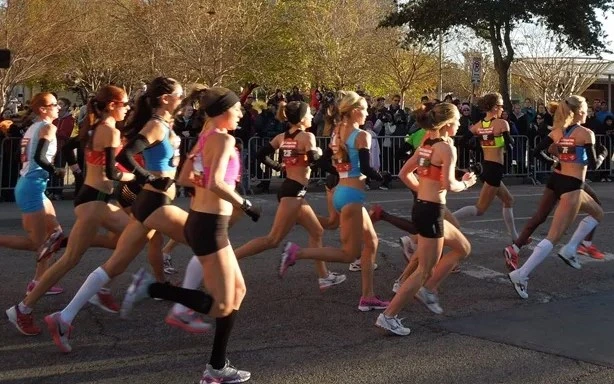
The Science of Squeeze: How Graduated Compression Works for Runners
Before we can even begin to debate the benefits, it’s essential to understand that a true compression sock is a piece of medical-grade technology, not just a tight tube of fabric. The magic behind its function lies in a principle called graduated compression. This is an engineered design where the pressure applied by the sock is not uniform but is precisely calibrated to be strongest at the ankle and gradually decrease as it moves up the leg towards the knee. This simple-sounding concept is the key to unlocking all the potential physiological benefits for a runner.
Think about it like this. When you run, your heart pumps oxygen-rich blood through your arteries to your hard-working leg muscles. The real challenge for your body is the return trip. Your veins have to carry deoxygenated blood and metabolic waste products (like lactic acid) from your feet all the way back up to your heart, fighting gravity every step of the way. Over the course of a long run, this system can become less efficient, leading to blood pooling in the lower legs, a feeling of “heavy legs,” and swelling. Graduated compression socks act as a mechanical assistant for this process. The firmest pressure at the ankle helps “squeeze” the veins, increasing the velocity of the blood flow, while the decreasing pressure gradient creates a gentle “milking” effect that continuously pushes blood upward, preventing it from backing up or pooling. As vascular surgeon Dr. Claire Griffin explains, compression socks effectively help prevent this backup of blood. This enhanced circulation is the foundational mechanism that underpins every other potential benefit, from performance enhancement to faster recovery.
The Performance Question: Do They Actually Make You Run Faster?
This is the million-dollar question for every competitive runner and the core of many brands’ marketing claims. Will putting on a pair of compression socks magically shave minutes off your personal best? The honest, science-backed answer is: probably not directly. While some runners swear by them for performance, the body of scientific research on the direct impact of compression socks on running speed or endurance during the activity itself is mixed and, for the most part, shows modest to negligible effects.
However, that doesn’t mean there’s no performance benefit. The effects are just more nuanced than a simple “faster or not” equation. Some studies have pointed toward a few subtle but potentially significant advantages:
- Improved Running Economy: This refers to the amount of oxygen your body needs to consume to maintain a certain pace. A handful of studies have suggested that wearing compression socks may slightly improve running economy. The theory is that by enhancing blood flow and potentially reducing muscle vibration, the muscles can work more efficiently, requiring less oxygen to produce the same amount of power.
- Reduced Muscle Oscillation: When your foot strikes the ground, a shockwave travels up your leg, causing your calf muscles to vibrate. Over thousands of strides, this oscillation can contribute to muscle fatigue and micro-trauma. Compression socks act as a supportive sheath, physically encasing the muscle and dampening this vibration. This can lead to a feeling of less fatigue, especially late in a long race like a marathon.
- Proprioceptive Feedback: Proprioception is your body’s sense of its position in space. The constant pressure of the sock on the skin of your foot, ankle, and calf can heighten this sense, making a runner feel more stable, secure, and “connected” to their stride.
So, while you shouldn’t market compression socks as a magic bullet for speed, you can frame them as a tool for enhancing running efficiency, reducing the impact of muscle fatigue, and improving biomechanical feedback, all of which contribute to a better overall running experience.
The Real Sweet Spot: Running Recovery and Reduced Soreness
While the debate about in-race performance continues, there is a much stronger scientific consensus on the significant benefits of wearing compression socks for post-run recovery. This is where the technology truly shines and where your brand can make its most powerful and credible claims. For many serious runners, the ability to recover faster and feel fresher for the next training session is even more valuable than shaving a few seconds off a race time. Consistent, high-quality training is the real key to improvement, and anything that facilitates that is a game-changer.
Here’s how it works. The same circulatory benefits that are subtle during the run become highly impactful when your body is in repair mode. After a hard workout, your muscles are filled with metabolic byproducts that contribute to that all-too-familiar feeling of Delayed Onset Muscle Soreness (DOMS).
- Accelerated Waste Removal: By continuing to wear compression socks for several hours after a run, you maintain that enhanced blood flow. This helps to more quickly flush out the waste products that cause inflammation and soreness, while simultaneously delivering fresh, oxygenated blood to the damaged muscle tissue to speed up repair. Kinesiologist Stephen M. Roth has explained the link between this process and the pain caused by lactic acid buildup.
- Reduced Swelling and Inflammation: The gentle pressure helps to limit the amount of swelling that occurs in the lower legs after a long, strenuous effort. By physically preventing excess fluid from accumulating in the tissue, the socks can significantly reduce the feeling of stiffness and pain associated with post-run inflammation.
- Less Muscle Damage: By mitigating the inflammatory response, compression socks can lead to measurably less muscle damage and a faster restoration of muscle function.
The end result is simple and powerful: runners who use compression socks for recovery consistently report feeling less sore and having “fresher legs” the day after a hard workout, allowing them to return to high-quality training sooner.
During the Run: The Case for Wearing Compression Socks Mid-Race
Wearing compression socks mid-race offers several advantages that go beyond just improving speed. For many runners, especially those tackling longer distances like half-marathons, marathons, or ultramarathons, comfort, support, and injury prevention become critical factors. These benefits provide strong reasons for runners to choose compression socks, making them a valuable product for athletic brands to promote.
One key benefit is the reduction of muscle vibration and fatigue. Over long distances, calf muscles experience constant oscillation that can cause micro-trauma and accelerate tiredness. Compression socks help stabilize these muscles, which can lead to less fatigue and stronger legs in the crucial final miles.
Another advantage is calf and shin protection. For trail runners, the socks serve as a shield against scratches from branches, rocks, or irritants like poison ivy. Road runners benefit from reduced abrasions caused by accidental scrapes, such as hitting a curb.
Compression socks also improve proprioception and stability, enhancing a runner’s body awareness and stride confidence. Many runners feel more “locked-in,” which can boost mental strength during challenging moments in a race.
Lastly, some runners report fewer calf cramps when wearing compression socks. While mostly anecdotal, this may be due to improved circulation and reduced muscle fatigue helping to prevent cramps, especially in hot weather or during intense efforts.
Together, these benefits promote a more comfortable, stable, and confident running experience—an attractive selling point for your brand.ate a more comfortable and confident running experience, which is a powerful selling proposition for any runner.
Choosing the Right Compression Level (mmHg) for Running
One of the most critical specifications for a performance compression sock is its pressure rating, measured in millimeters of mercury (mmHg). This isn’t a fashion statement; it’s a medical measurement that dictates the sock’s function. As a brand, offering accurately tested and clearly labeled compression levels is essential for credibility and for ensuring your customers get the right product for their needs. A sock that is too loose will offer no benefit, while one that is too tight can be uncomfortable and even counterproductive.
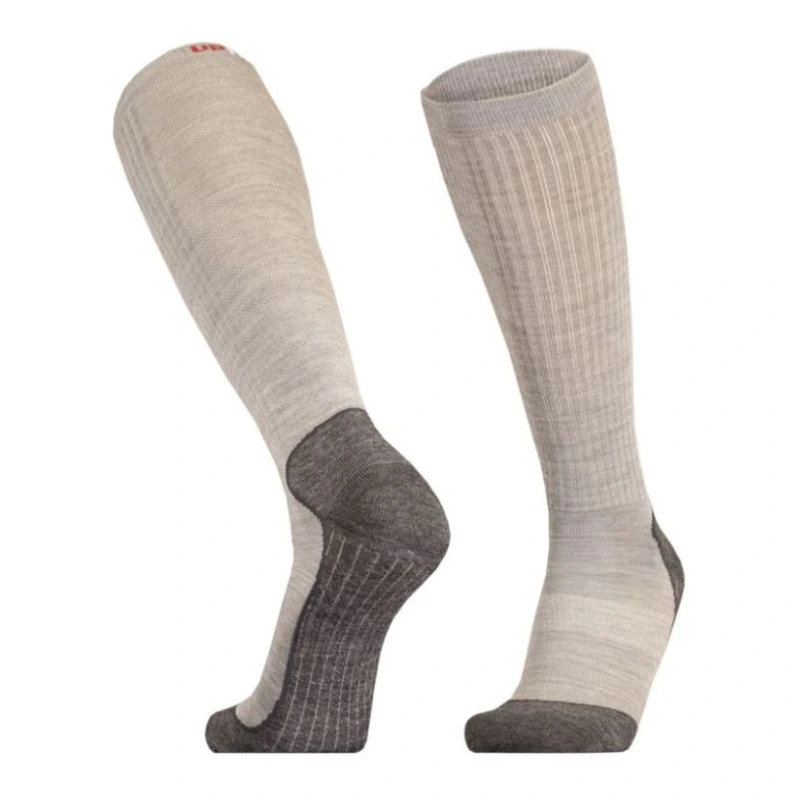
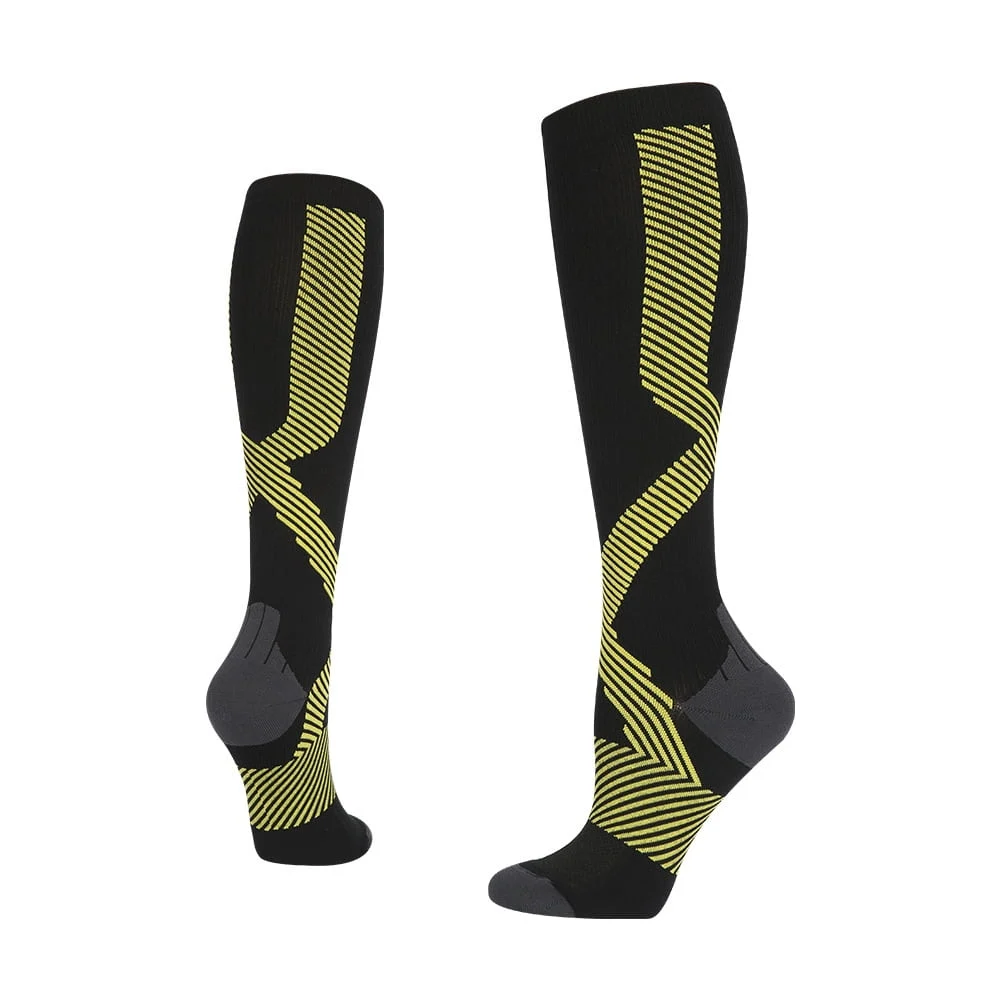
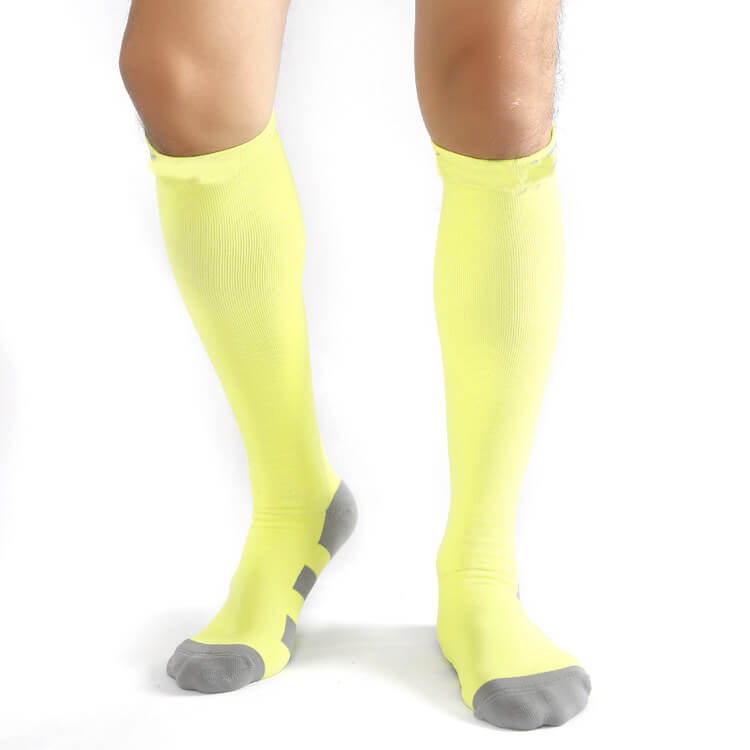
Let’s break down the levels relevant to runners.
- 15-20 mmHg (Moderate Compression): This level is often considered the ideal entry point and is perfect for wearing during a run. It provides all the benefits of muscle support and reduced vibration without feeling overly restrictive. It’s a great choice for runners who want support but prioritize comfort over the longest distances. Many daily-wear compression socks also fall into this range.
- 20-30 mmHg (Firm Compression): This is the sweet spot for many serious athletes and is widely regarded as the most effective level for post-run recovery. The firmer pressure is more effective at flushing out metabolic waste and reducing swelling after a strenuous effort. Many runners also prefer this level for in-race use, especially for shorter, high-intensity races where maximum muscle support is desired. This is one of the most popular compression levels sold for sports applications.
- 30-40 mmHg (Medical-Grade Compression): This level is generally considered therapeutic and is typically used to manage more significant medical conditions like varicose veins or severe edema. It is not recommended for general athletic use unless a runner is specifically advised to use it by a doctor.
Here’s a quick reference table for your brand’s product development and marketing:
| Compression Level | Primary Use Case for Runners | Key Benefit |
|---|---|---|
| 15-20 mmHg | During Running / All-Day Wear | In-race comfort, muscle stabilization, light support. |
| 20-30 mmHg | Post-Run Recovery / Performance | Maximum recovery benefits, reduced soreness, firm race-day support. |
| 30-40 mmHg | Medical Use Only | Not for athletic use unless prescribed by a doctor. |
It’s crucial to partner with a manufacturer that uses professional testing equipment to verify these pressure ratings, ensuring your product delivers on its promise.
Material Matters: Engineering the Perfect Fabric for a Runner’s Foot
The effectiveness of a running compression sock isn’t just about the squeeze; it’s equally about the materials used to make it. A runner’s foot is a high-stress environment: it sweats, it swells, and it endures thousands of high-impact strikes. The right fabric blend is critical for managing moisture, regulating temperature, and ensuring durability, all while providing the necessary elasticity for graduated compression. For your brand, the choice of materials is a key differentiator that directly impacts performance and comfort.
Here are the key components of a high-performance running sock fabric.
- The Moisture-Wicking Base (Synthetics): The foundation of a great running sock is a synthetic fiber that excels at moisture management. Unlike cotton, which absorbs sweat and becomes heavy, synthetics pull moisture away from the skin to the surface of the sock, where it can evaporate.
- Nylon/Polyester: These are the workhorses of athletic socks, providing excellent durability and moisture-wicking properties. Specialty polyesters like Coolmax are engineered with channeled fibers to be even more effective at this process.
- The Elastic Core (Spandex/Lycra): This is the magic ingredient that provides the compression. Spandex fibers are incredibly stretchy and resilient. Using a high-quality branded elastic like Lycra ensures that the sock maintains its compressive properties wash after wash and doesn’t stretch out over time. A quality compression sock can last from six months to a year with proper care.
- The Temperature-Regulating Option (Merino Wool): For runners who race in a variety of climates, Merino wool is a premium choice. Its natural fibers are incredibly efficient at regulating temperature, keeping feet warm in the cold and cool in the heat. It’s also naturally odor-resistant and feels soft against the skin.
As a brand, you can create different product lines based on these materials: a lightweight, wicking sock for summer racing and a temperature-regulating wool blend for all-season trail running.
Sock Construction: The Details That Separate Good from Great
Compression socks with similar mmHg ratings and materials can feel very different during a run. The distinction often comes down to construction details, which greatly influence comfort and performance, especially for long-distance runners. For performance-focused brands, mastering these nuances is critical to creating socks that stand out.
Seamless Toe Design
A truly seamless or hand-linked toe is vital. Traditional socks have thick seams that can irritate toes and cause blisters over time. Premium running socks eliminate this issue with a flat, irritation-free seam that enhances comfort on long runs.
Targeted Cushioning
Runners have different preferences, from minimalist to cushioned socks. The best designs offer cushioning precisely where it’s needed—under the heel and ball of the foot—providing shock absorption without unnecessary bulk. This balance protects impact zones while maintaining overall lightness and breathability.
Anatomical Fit
Left and right feet are not the same. Socks shaped specifically for each foot reduce fabric bunching around the arch and toes, lowering blister risks and improving overall fit.
Breathable Mesh Zones
Advanced socks include mesh panels on the top of the foot to boost airflow. These open-weave areas complement moisture-wicking fabrics, keeping feet cooler and drier during intense runs.
Attention to these construction details transforms a compression sock from merely functional to virtually invisible on the runner’s foot. This combination of comfort, fit, and performance defines truly great running socks.y great piece of gear.
The Great Debate: Compression Socks vs. Calf Sleeves
In any discussion about lower leg compression for runners, the “socks vs. sleeves” debate is inevitable. Both products aim to provide compression to the calf muscles, but they do so in slightly different ways, and each has its own set of pros and cons. Offering both options can be a smart strategy for a brand, as it caters to the specific preferences of different runners. Understanding these differences is key to guiding your customers to the right choice for them.
Let’s compare them head-to-head.
Compression Socks
These are full socks that cover the foot, ankle, and calf, typically ending just below the knee 8.
- Pros: They provide true, continuous graduated compression starting from the foot, which is more effective for promoting overall circulation and reducing foot/ankle swelling. The integrated design means you have one piece of gear to put on.
- Cons: You are locked into the sock’s footbed. If you have a specific preference for a different running sock (e.g., one with a different thickness or material), you can’t wear it.
Calf Sleeves
These are simply fabric tubes that cover the area from the ankle to the top of the calf, leaving the foot bare.
- Pros: The biggest advantage is versatility. A runner can pair the sleeves with their absolute favorite running sock, whatever brand or style that may be. They are also slightly easier to take off after a muddy trail run without making a mess.
- Cons: They do not provide compression to the foot or ankle, so they are less effective at preventing foot swelling. The compression is not truly “graduated” from the foot up, which may slightly reduce their circulatory benefit compared to a full sock.
Here’s a simple comparison table:
| Feature | Compression Socks | Calf Sleeves |
|---|---|---|
| Circulation | Superior (graduated from foot up) | Good (focused on calf) |
| Foot Swelling | Helps prevent | No effect |
| Versatility | Low (footbed is fixed) | High (pair with any sock) |
| Convenience | Simple (one item) | Simple (easy to remove) |
| Achilles Support | Provides some support to the ankle/Achilles | No support to the ankle/Achilles |
Ultimately, the choice is personal. Socks are technically superior for circulation, while sleeves offer unbeatable freedom of choice for the foot.
How to Find the Right Fit: A Sizing Guide for Brands and Runners
All the advanced technology in a compression sock is rendered useless if it doesn’t fit correctly. Proper sizing is absolutely critical to ensure the sock can deliver its intended graduated pressure profile. A sock that’s too loose won’t provide any meaningful compression. A sock that’s too tight will be uncomfortable, difficult to put on, and could even be constrictive. For a brand, providing a clear, accurate sizing guide is a fundamental part of customer service and product effectiveness.
It’s not about shoe size. This is the most common mistake runners make. While shoe size can be a secondary reference, the primary measurements for sizing a knee-high compression sock are based on leg circumference.
- Ankle Circumference: This is the most important measurement. The ankle is where the graduated compression starts and where the pressure is tightest. An accurate ankle measurement ensures the foundation of the compression is correct.
- Calf Circumference: This is the second key measurement, taken at the widest point of the calf muscle. This ensures the sock will be snug enough to provide support without being so tight that it cuts off circulation at the top band.
A brand’s responsibility is to educate. Your product packaging and website should feature a detailed sizing chart that clearly shows customers how to measure themselves. The chart should then correlate these ankle and calf measurements (in inches or centimeters) to the appropriate sock size (e.g., S, M, L, XL). Including a simple diagram or video showing exactly where to place the measuring tape can be incredibly helpful. Emphasizing that “fit is performance” will help guide your customers to choose the right size, leading to higher satisfaction and better results.
Conclusion: A Valuable Tool in the Runner’s Toolkit
Compression socks are a valuable tool for most runners, enhancing comfort during runs and speeding recovery afterward. Scientific evidence shows they improve circulation and reduce muscle soreness, helping athletes train more consistently. During runs, they also reduce muscle vibration and boost stability, especially over long distances.
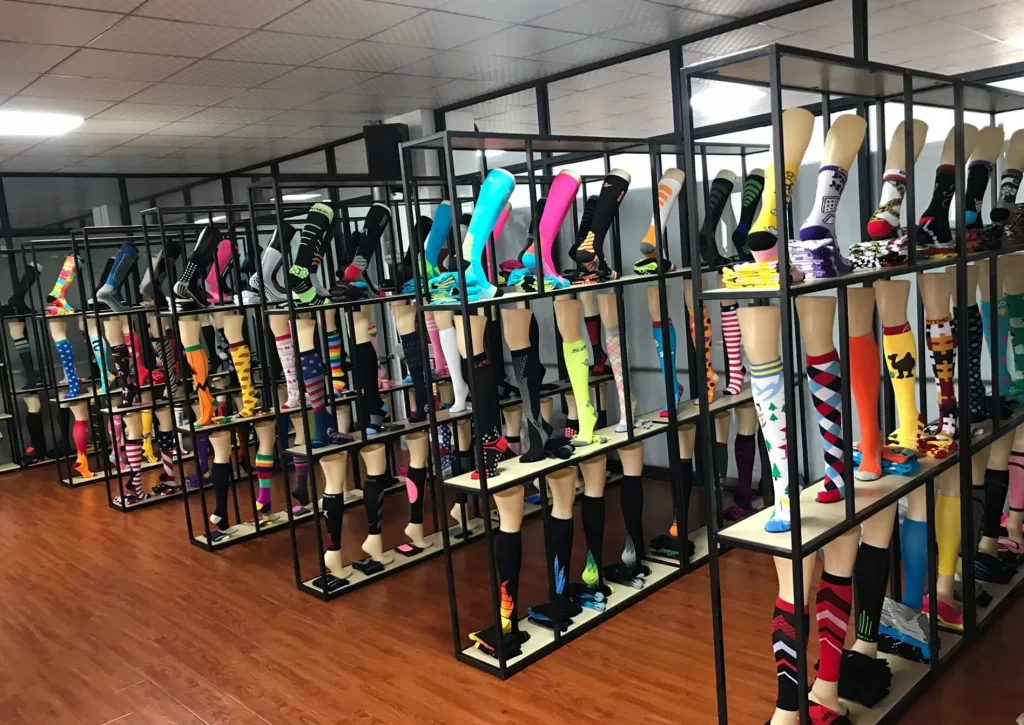
For performance brands, this presents a clear opportunity to meet growing demand with high-quality, well-designed compression socks. Partnering with an experienced manufacturer is essential to get the technical details right.
At Max Hosiery, we specialize in creating premium compression socks tailored to athletes’ needs. Contact us today to develop your next-generation running sock and offer your customers real, science-backed benefits.
FAQ Section
Q1: How long do running compression socks last?
With proper care (machine washing on a gentle cycle and air drying), a high-quality pair of compression socks made with durable materials like Lycra should maintain their compressive properties for about 6 months to 1 year of regular use.
Q2: Should I wear them during or after my run for the best results?
Both have distinct benefits. For maximum recovery, wearing them for several hours after a hard run is most effective for reducing soreness. For in-race comfort and muscle support, wearing them during the run is ideal. Many serious runners do both.
Q3: What’s the difference between cheap compression socks and premium ones?
The difference lies in three key areas: 1) materials, with premium socks using high-resilience elastics like Lycra; 2) verified compression, with reputable brands using professional equipment to test and guarantee their mmHg rating; and 3) construction, such as a true seamless toe to prevent blisters.
Q4: Can I wear the same pair for running and then for recovery?
While you can, it’s best to switch to a fresh, dry pair for recovery. After a run, your socks will be damp with sweat, which isn’t ideal for long-term wear from a hygiene or comfort perspective.
Q5: Are there any risks to wearing compression socks for running?
For healthy individuals, the risks are minimal. The main issue comes from improper sizing, which can be uncomfortable or ineffective. However, runners with underlying circulatory conditions, such as Peripheral Artery Disease (PAD), should always consult a doctor before using any compression products.
